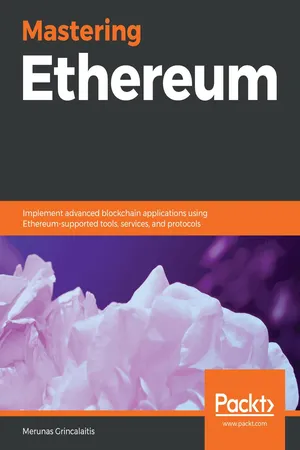
Mastering Ethereum
Implement advanced blockchain applications using Ethereum-supported tools, services, and protocols
- 490 pages
- English
- ePUB (mobile friendly)
- Available on iOS & Android
Mastering Ethereum
Implement advanced blockchain applications using Ethereum-supported tools, services, and protocols
About this book
An expert guide to implementing fast, secure, and scalable decentralized applications that work with thousands of users in real time
Key Features
- Implement advanced features of the Ethereum network to build powerful decentralized applications
- Build smart contracts on different domains using the programming techniques of Solidity and Vyper
- Explore the architecture of Ethereum network to understand advanced use cases of blockchain development
Book Description
Ethereum is one of the commonly used platforms for building blockchain applications. It's a decentralized platform for applications that can run exactly as programmed without being affected by fraud, censorship, or third-party interference.
This book will give you a deep understanding of how blockchain works so that you can discover the entire ecosystem, core components, and its implementations. You will get started by understanding how to configure and work with various Ethereum protocols for developing dApps. Next, you will learn to code and create powerful smart contracts that scale with Solidity and Vyper. You will then explore the building blocks of the dApps architecture, and gain insights on how to create your own dApp through a variety of real-world examples. The book will even guide you on how to deploy your dApps on multiple Ethereum instances with the required best practices and techniques. The next few chapters will delve into advanced topics such as, building advanced smart contracts and multi-page frontends using Ethereum blockchain. You will also focus on implementing machine learning techniques to build decentralized autonomous applications, in addition to covering several use cases across a variety of domains such as, social media and e-commerce.
By the end of this book, you will have the expertise you need to build decentralized autonomous applications confidently.
What you will learn
- Apply scalability solutions on dApps with Plasma and state channels
- Understand the important metrics of blockchain for analyzing and determining its state
- Develop a decentralized web application using React.js and Node.js
- Create oracles with Node.js to provide external data to smart contracts
- Get to grips with using Etherscan and block explorers for various transactions
- Explore web3.js, Solidity, and Vyper for dApps communication
- Deploy apps with multiple Ethereum instances including TestRPC, private chain, test chain, and mainnet
Who this book is for
This book is for anyone who wants to build fast, highly secure, and transactional decentralized applications. If you are an Ethereum developer looking to perfect your existing skills in building powerful blockchain applications, then this book is for you. Basic knowledge of Ethereum and blockchain is necessary to understand the concepts covered in this book.
Frequently asked questions
- Essential is ideal for learners and professionals who enjoy exploring a wide range of subjects. Access the Essential Library with 800,000+ trusted titles and best-sellers across business, personal growth, and the humanities. Includes unlimited reading time and Standard Read Aloud voice.
- Complete: Perfect for advanced learners and researchers needing full, unrestricted access. Unlock 1.4M+ books across hundreds of subjects, including academic and specialized titles. The Complete Plan also includes advanced features like Premium Read Aloud and Research Assistant.
Please note we cannot support devices running on iOS 13 and Android 7 or earlier. Learn more about using the app.
Information
Section 1: Blockchain - Ethereum Refresher
- Chapter 1, Blockchain Architecture
- Chapter 2, Ethereum Ecosystem
- Chapter 3, Ethereum Assets
Blockchain Architecture
- Beyond Ethereum
- The EEA
- Understanding the Ethereum blockchain
- A high-level overview of how smart contracts work
- Essential smart contract programming
Beyond Ethereum
Explaining Ethereum
Ethereum's history
Ethereum's development
- Frontier
- Homestead
- Metropolis
- Serenity
The EEA
- The EEA's vision
- The EEA membership
- The EEA architecture
The EEA's vision
- Be an open source standard, not a product:
- Address enterprise development requirements:
- Share improvements between public and private Ethereum:
- Leverage existing standards:
Table of contents
- Title Page
- Copyrights and Credits
- About Packt
- Contributors
- Preface
- Section 1: Blockchain - Ethereum Refresher
- Blockchain Architecture
- Ethereum Ecosystems
- Ethereum Assets
- Section 2: Decentralized Application Development Workflow
- Mastering Smart Contracts
- Mastering dApps
- Tools, Frameworks, Components, and Services
- Deployment on Testnet
- Various dApps Integrations
- Decentralized Exchanges Workflow
- Section 3: Ethereum Implementations
- Machine Learning on the Ethereum Blockchain
- Creating a Blockchain-based Social Media Platform
- Creating a Blockchain-Based E-Commerce Marketplace
- Other Books You May Enjoy